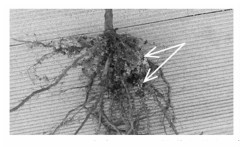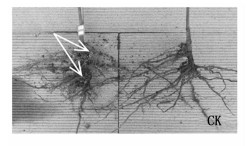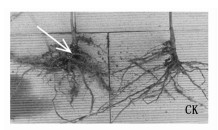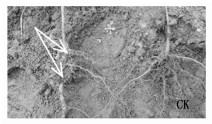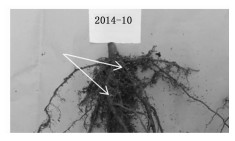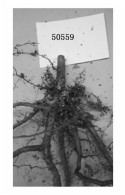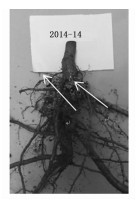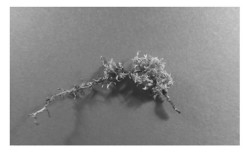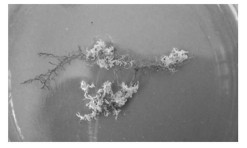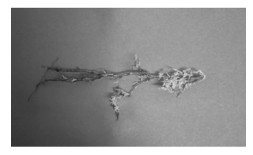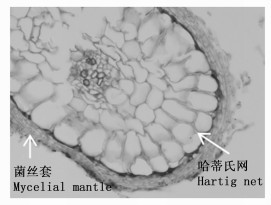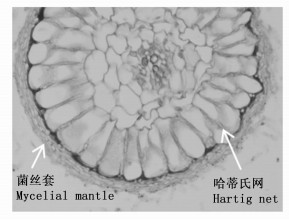-
近年来, 随着林下经济的蓬勃发展, 林下食用菌栽培业取得了较大的发展, 但栽培种类仅局限于已能进行大规模人工栽培的种类, 如香菇、平菇、杏鲍菇、木耳等。目前, 不能进行人工栽培却能真正与树木形成互惠互利关系的共生菌根食用菌栽培模式已成为研究方向, 这种栽培模式是“营建新型生态经济林——食用菌根菌经济林模式”[1], 即在营造经济林之前选择好树种和与其能共生的珍贵食用菌根菌种类, 人工使其合成菌根, 从单一生产林果为主转变为以生产林果和珍贵食用菌根菌为主, 既增加了经济收入, 又充分发挥了菌根共生关系的优势[2]。国际上主要通过培养菌根化幼苗, 建立种植园的方式在多种珍贵食用菌根菌生产上取得了成功, 而我国研究人员在黑孢块菌、乳牛肝菌、红汁乳菇等珍贵食用菌根菌栽培方面同样取得了较大进展[3-4]。目前, 食用菌根菌已逐渐成为农林业的新宠儿[5], 不仅因为这些食用菌根菌具有独特的食用和药用价值[6-7], 而且还能促进树木生长、提高产量、增强抗性、改良土壤。板栗(Castanea mollissima Bl.)是我国优良的经济林树种, 且能与多种珍贵食用菌根菌共生, 探索和发展板栗食用菌根菌生态林, 既在一定程度上解决我国某些地区板栗发展趋于饱和、缺乏经济增长的现状, 又能结合老龄板栗树的更新, 引入食用菌根菌栽培, 增加新的经济增长点。
发展板栗食用菌根菌经济林模式的基础是目的菌种能否与板栗人工合成菌根, 笔者在研制成功板栗食用菌根菌固体菌剂的基础上[8], 进行了板栗接种食用菌根菌菌根化效果试验, 以验证供试菌种能否侵染板栗根系, 能否形成菌根的典型结构——菌丝套和哈蒂氏网, 验证固体菌剂的有效性, 同时观测接种食用菌根菌对板栗幼苗生长的影响。
HTML
-
育苗试验地位于浙江省诸暨市浬浦镇兼溪村(29°N, 120°E), 属亚热带季风气候区, 四季分明, 雨水较多, 光照充足。原为浙江省板栗主产区之一, 但近年来由于效益下降、林龄老化等原因, 板栗发展已停滞。本试验的最终目的就是引入食用菌根菌栽培, 以增加板栗种植效益。
-
本文供试食用菌根菌及来源见表 1。菌种由中国林科院菌根研究开发中心经过固体发酵后制成固体菌剂, 用于育苗试验。
菌种名称Name of mycorrhiza fungi 菌株编号Strain number 菌种来源Strain sources 大红菇
(Russula alutacea Fr.)2014-10 中国林科院菌根研究开发中心采集、分离
Collection and separation of the research and development center of mycorrhizae, CAF.红绒盖牛肝菌
(Xerocomus chrysenteron Bull.ex Fr.)2014-14 中国林科院菌根研究开发中心采集、分离
Collection and separation of the research and development center of mycorrhizae, CAF.美味牛肝菌
(Boletus edulis Bull.Fr.)50559 中国农业菌种保藏中心提供
Provided by ACCC.Table 1. The name and sources of the tested strains
1.1. 试验地点
1.2. 供试食用菌根菌种类及来源
-
试验共设4个处理: (1)接种大红菇; (2)接种红绒盖牛肝菌; (3): 接种美味牛肝菌; (4)空白对照(CK), 即不接种菌根剂。采用随机区组设置, 3次重复, 每处理播种30粒板栗种子。
-
育苗地土壤经深翻、暴晒、耙平后做成苗床, 每处理之间挖深40 cm、宽30 cm的隔离沟。根据育苗量, 每处理设1 m2苗床。板栗种子经过低温层积催芽后于2015年3月底播种。
-
首先用量杯量取15 cm3的固体菌根剂放于播种穴底部, 然后覆盖一层约1 cm厚的土, 再将种子播种在土上, 最后覆土压实。处理与对照均按常规方式管理。
-
于2015年11月底, 调查苗高、地径、侧根数、侧根长、根系干质量。在量取各处理板栗幼苗的苗高和地径后, 将幼苗连根挖出, 尽量保留完整根系, 观测根系菌根化情况; 每区组每处理各选取完整的根系5株带回试验室, 自然风干后称根系干质量; 每处理随机选取完整的根系5株记录侧根数, 测量侧根总长[2]。
-
在现场利用目测法[9]观察统计幼苗菌根化率(幼苗菌根化率=有菌根的株数/总株数×100%); 利用计数统计调查法[9]统计吸收根菌根化率(吸收根菌根化率=具菌根的吸收根/总吸收根×100%)。
-
肉眼或辅助体视镜观察记录菌根的颜色、形状、菌丝套及外延菌丝情况。选取结构良好的典型菌根存放于FAA固定液中带回试验室进行显微观察, 并采用石蜡切片及番红固绿对染[2]的方法制作菌根横切片和纵切片, 进行显微观察和照相。
2.1. 试验设置
2.2. 育苗及接种方法
2.2.1. 育苗地及种子处理
2.2.2. 接种方法
2.3. 调查项目及方法
2.3.1. 板栗幼苗生长指标调查
2.3.2. 板栗幼苗人工合成菌根效果检测
2.3.3. 板栗菌根外观及微观结构观察
-
测量和方差分析的结果(表 2、3)表明: 板栗幼苗苗高、地径各区组间差异不显著, 各处理间差异显著(P < 0.05); 板栗幼苗根系干质量区组间差异不显著, 各处理间差异极显著(P < 0.01)。
变异来源
Sources of variation自由度
Freedom均方
Mean squareF F0.05 F0.01 苗高
Seedling height地径
Ground diameter根系干质量
Root dry weight区组Block 2 50.50 3.38 0.033 0.72 4.76 9.78 处理Processing 3 121.06 8.10* 6.10* 21.63** 误差Chance error 6 14.95 注: *表示差异显著(P < 0.05), **表示差异极显著(P < 0.01), 下同。
Note: * the difference was significant (P < 0.05), * * the difference was very significant (P < 0.01), the same below.Table 2. Variation analysis of seedling height, basal diameter and root dry biomass of Chinese chestnut seedlings
处理Processing 苗高Seedling height 地径Ground diameter 根系干质量Root dry weight 平均值/cm
Average/cm较CK提高/%
Improve than the CK/%平均值/mm
Average/mm较CK提高/%
Improve than the CK/%平均值/g
Average/g较CK提高/%
Improve than the CK/%大红菇Russula alutacea Fr. 60.8a 32.5 8.61a 19.4 19.97A 18.9 红绒盖牛肝菌Xerocomus chrysenteron Bull.ex Fr. 56.9a 24.0 8.23a 14.1 21.04A 25.3 美味牛肝菌Boletus edulis Bull.Fr. 56.3a 22.7 7.57b 5.0 19.16A 14.1 对照CK 45.9b - 7.21b - 16.79B - 注: 同列中不同小写字母表示差异显著, 不同大写字母表示差异极显著, 下同。
Note: in the same column, the different small letters indicate significant difference, the difference capital letters indicate very significant, the same below.Table 3. The multiple comparison of the average seedling height, basal diameter and root dry biomass of Chinese chestnut seedling
由表 3可见: 各菌种处理苗高均显著高于对照, 大红菇、红绒盖牛肝菌和美味牛肝菌处理的平均苗高比对照分别提高32.5%、24.0%和22.7%, 各菌种间平均苗高差异不显著, 说明接种食用菌根菌菌种后, 对当年生幼苗的高生长有显著的促进作用; 大红菇和红绒盖牛肝菌处理幼苗的平均地径比对照分别提高19.4%和14.1%, 与对照差异显著, 而美味牛肝菌处理后幼苗的平均地径仅比对照提高5.0%, 二者间差异不显著。
大红菇、红绒盖牛肝菌和美味牛肝菌处理后根系平均干质量比对照分别提高18.9%、25.3%和14.1%, 均与对照差异极显著。
由表 4、5可见: 各菌种处理的侧根数和侧根总长均与对照差异极显著, 大红菇、红绒盖牛肝菌和美味牛肝菌处理平均侧根数分别比对照提高16.0%、14.1%和12.1%, 平均侧根总长分别比对照提高26.8%、28.9%和44.8%, 说明接种食用菌根菌对板栗幼苗根系的生长发育具有极显著的促进作用。由图 1(左为菌根化苗, 右为对照苗)可见: 大红菇处理的菌根化苗苗高、地径均优于对照, 根系比对照苗更发达, 侧根尤其是吸收根更多。图 2为菌种大红菇(2014-10)与板栗幼苗形成的菌根化根系, 图中箭头所指为吸收根所形成的白色菌根。
变异来源
Sources of variation自由度
FreedomF F0.05 F0.01 侧根数
The number of lateral roots侧根总长
Lateral root length处理Processing 3 20.55** 27.6** 3.24 5.29 误差Chance error 16 Table 4. Variation analysis of lateral roots number and lateral roots length of Chinese chestnut seedlings
处理Processing 侧根数The number of lateral roots 侧根总长Lateral root length 平均值/条
Average较CK提高/%
Improve than the CK/%平均值/cm
Average/cm较CK提高/%
Improve than the CK/%大红菇Russula alutacea Fr. 47.8A 16.0 410.0B 26.8 红绒盖牛肝菌Xerocomus chrysenteron Bull.ex Fr. 47.0A 14.1 416.6B 28.9 美味牛肝菌Boletus edulis Bull.Fr. 46.2A 12.1 468.2A 44.8 对照CK 41.2B - 323.3C - Table 5. The multiple comparison of the average lateral roots number and lateral roots length of Chinese chestnut seedlings

Figure 2. 2014-10 and chestnut formation of mycorrhiza roots(The arrow refers to the mycorrhizal, the same below)
由图 3~5(左为菌根化根系, 右为对照根系)发现: 各菌种处理形成的菌根化根系不仅侧根多, 而且吸收根丰富, 并形成了大量的白色菌根。
综合以上调查结果, 生长指标在3个食用菌根菌间差异不显著, 说明这3个菌种对板栗幼苗生长指标的促进作用一致。
-
通过对各处理幼苗根系的观察发现: 3个菌种均与板栗根系形成了菌根。利用目测法和计数统计法统计幼苗菌根化率和吸收根菌根化率。由表 6可见: 接种食用菌根菌后, 各菌种均与板栗幼苗根系形成菌根, 幼苗平均菌根化率均高于80%, 吸收根平均菌根化率均≥50%。由图 6~8可见: 大红菇(2014-10)、红绒盖牛肝菌(2014-14)和美味牛肝菌(50559)与板栗形成菌根化根系, 大量的吸收根形成了白色的菌根。3个菌种处理板栗幼苗的部分吸收根特写照片(图 9~11)表明: 吸收根基本形成了白色菌根, 说明板栗幼苗根系的菌根化程度较高[2]。对照根系也有少量的菌根, 这可能是土壤中的土著菌根菌造成的, 由于其菌的数量较少, 因此, 菌根化率均显著低于人工接种, 虽然幼苗菌根化率达14.8%, 但平均吸收根菌根化率只有3%, 基本可以忽略不计。
处理
Processing幼苗平均菌根化率/%
Average infection rate of seedlings/%吸收根平均菌根化率/%
Average infection rate of absorbing root大红菇Russula alutacea Fr. 95.8 57 红绒盖牛肝菌
Xerocomus chrysenteron Bull.ex Fr.87.0 53 美味牛肝菌
Boletus edulis Bull.Fr.96.7 50 CK 14.8 3 Table 6. The investigation of the average mycorrhization rate of seedlings and absorbing roots of Chinese chestnut seedlings
-
选取典型菌根, 通过肉眼或体视镜观察发现, 3个菌种与板栗幼苗根系形成的菌根均可见明显的菌丝套结构, 外延菌丝较多(表 7)。选取典型菌根, 制作石蜡切片, 经显微镜观察, 吸收根横切片及纵切片上均可见菌丝束缠绕在吸收根尖表面, 即形成了菌丝套。同时在根皮层外侧细胞间隙亦可见明显的菌丝侵入, 从菌根的横切片上可观察到念珠状结构, 即形成了典型的哈蒂氏网结构。由图 12~14可以清晰地观察到根表皮外包裹的菌丝套和根皮层外侧细胞间的哈蒂氏网结构。可见, 3种食用菌根菌菌种均与板栗幼苗根系共生并形成了典型的菌根结构——菌丝套和哈蒂氏网, 表明板栗与3种食用菌根菌人工合成菌根成功。详细的微观结构观察将另文描述。
菌种
Strain菌根颜色
Mycorrhizal color外观描述
Mycorrhizal appearance大红菇
Russula alutacea Fr.白色
White顶端稍膨大, 以二叉状、塔状为主, 具有明显的菌丝套, 外延菌丝多。
There is swelling on the top of the mycorrhizae, with more two fork and tower shaped, with the clearly mycelial mantle, and more external mycelium.红绒盖牛肝菌
Xerocomus chrysenteron Bull.ex Fr白色
White顶端基本无膨大, 以二叉状和单棒状为主, 具有明显的菌丝套, 外延菌丝较多。
There is no swelling on the top of the mycorrhizae, with two fork and single rod like, with the clearly mycelial mantle, and more external mycelium.美味牛肝菌
Boletus edulis Bull.Fr.白色
White顶端基本无膨大, 以二叉状、羽状为主, 具有明显的菌丝套, 外延菌丝较多。
There is no swelling on the top of the mycorrhizae, with two fork and feather dominated like, with the clearly mycelial mantle, and more external mycelium.Table 7. The morphological characteristics of mycorhiza of Chinese chestnut seedlings inoculated with different solid inocula

Figure 12. Microscopic photographs of the apical transverse sections of the mycorrhiza root formed with strain 2014-10(×400)
3.1. 食用菌根菌处理对板栗幼苗生长指标影响调查结果
3.2. 板栗幼苗根系菌根化效果
3.3. 菌根外观形状及微观观察
-
(1) 本文在板栗播种的同时接种食用菌根菌, 探讨其与板栗幼苗根系的菌根化效果及对板栗幼苗的促生效应。国内其他同类研究也多集中于外生菌根真菌对板栗幼苗的生长效应方面, 目的是以促进板栗幼苗生长为主。本文在食用菌根真菌对幼苗生长指标的影响方面与其他同类研究结果基本相同, 即接种菌根真菌后对幼苗的各项生长指标具有显著的促进作用。石青莲等[10]、吕全等[11]、秦岭等[12]、秦天天等[13]在各自的研究中均得出了类似结果, 而且在光合效率、抗旱性能等方面也证明了菌根真菌的有效性。
(2) 本研究与国内其他同类研究有所区别的方面: 一是以食用菌根真菌作为研究对象, 目的是为营建“板栗食用菌根菌经济林”提供理论和实践基础。二是对各项生长指标进行分析的同时, 还重点对各菌种与板栗幼苗根系的侵染率尤其是吸收根侵染率进行了比较详细的分析和观察。结果表明: 供试的3种食用菌根真菌固体菌剂与板栗幼苗根系的菌根化强度较高, 验证了所培养的固体菌剂用于板栗食用菌根菌栽培的有效性。本研究采用的优良菌种及其高效固体菌剂培养方法、直接穴施的接种方式是保证高侵染率的重要原因, 直接穴施使菌体更集中, 胚根长出后能第一时间与高浓度菌接触, 可以大幅度提高侵染率[2]。只有达到一定的菌根化强度, 菌根才能对共生树种各方面产生有益作用[14], 同时才能更有利于食用菌根菌在土壤中的繁殖, 为子实体的萌发生长奠定基础。
(3) “板栗食用菌根菌经济林”营建模式一旦建立起来, 既能发挥菌根对板栗多方面的有益作用, 如提高养分吸收及利用率, 提高抗旱抗病性, 促进生长等, 又能培养林下优良珍贵的食用菌根真菌, 达到增加林农收入的目的。从菌根的原理看, 它的效应是长期的[2], 但具体到人工接种后板栗菌根体系的持续性效应, 需多年的持续监测才能确定, 这一点也关系到将来“板栗食用菌根菌经济林”效益持续性, 本研究也将对此进行长期的跟踪监测。
(4) 本项研究为“板栗食用菌根菌经济林”的营建提供了优良的菌种及有效的接种体, 但除此以外还需要探索食用菌根菌萌发子实体的各种条件及营建的正确方式, 因此, 还需要进行更进一步的试验研究。
-
(1) 板栗种子播种时分别接种大红菇、红绒盖牛肝菌、美味牛肝菌3个食用菌根真菌纯培养固体菌剂, 8个月后调查结果显示, 3个菌种均与板栗幼苗根系共生, 菌根化效果良好, 并形成了菌根的典型结构——菌丝套和哈蒂氏网, 幼苗平均菌根化率均 > 80%, 吸收根平均菌根化率均≥50%, 菌根化强度较高, 从而验证了3个菌种固体菌剂的有效性, 说明笔者培养的3个菌种固体菌剂可以作为板栗食用菌根菌栽培的接种体用于生产实践, 为进一步探索营建“板栗食用菌根菌经济林”提供了基础。
(2) 3个供试菌种与板栗幼苗根系形成菌根后, 板栗幼苗苗高、地径与对照的差异均显著, 根系干质量、侧根数和侧根总长与对照的差异均极显著, 说明3个供试菌种菌根化后对板栗幼苗生长具有显著的促生效应, 进一步说明接种食用菌根菌后不仅能采收优良食用菌, 还能促进板栗生长。

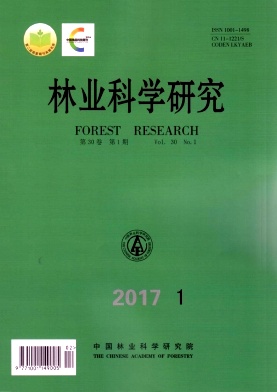


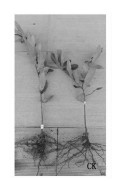













 DownLoad:
DownLoad:
